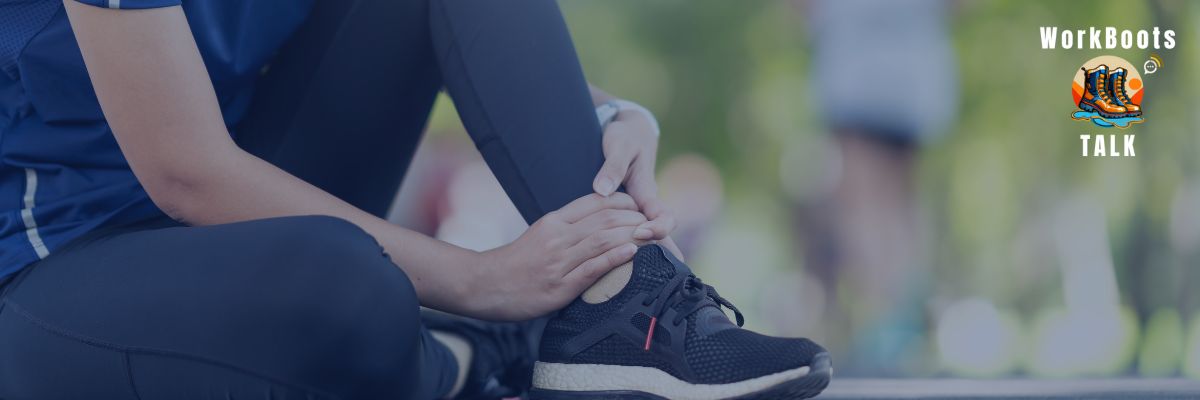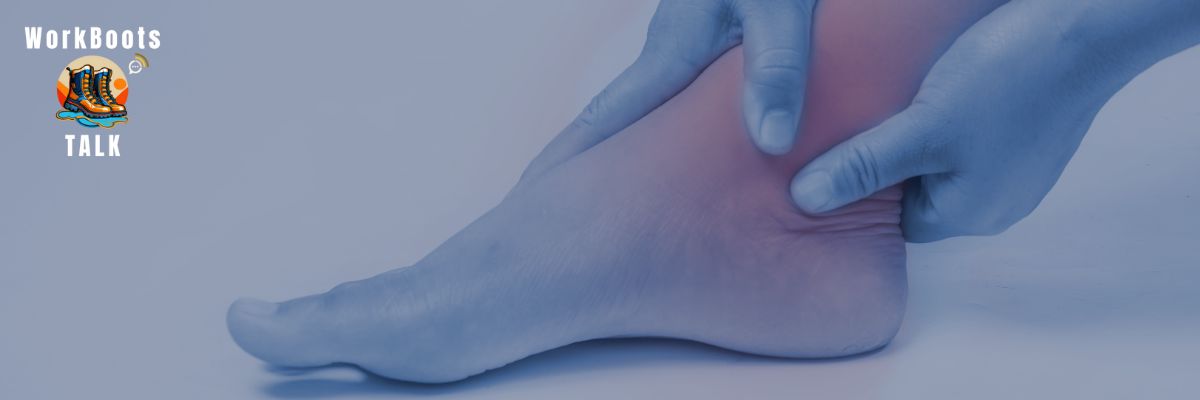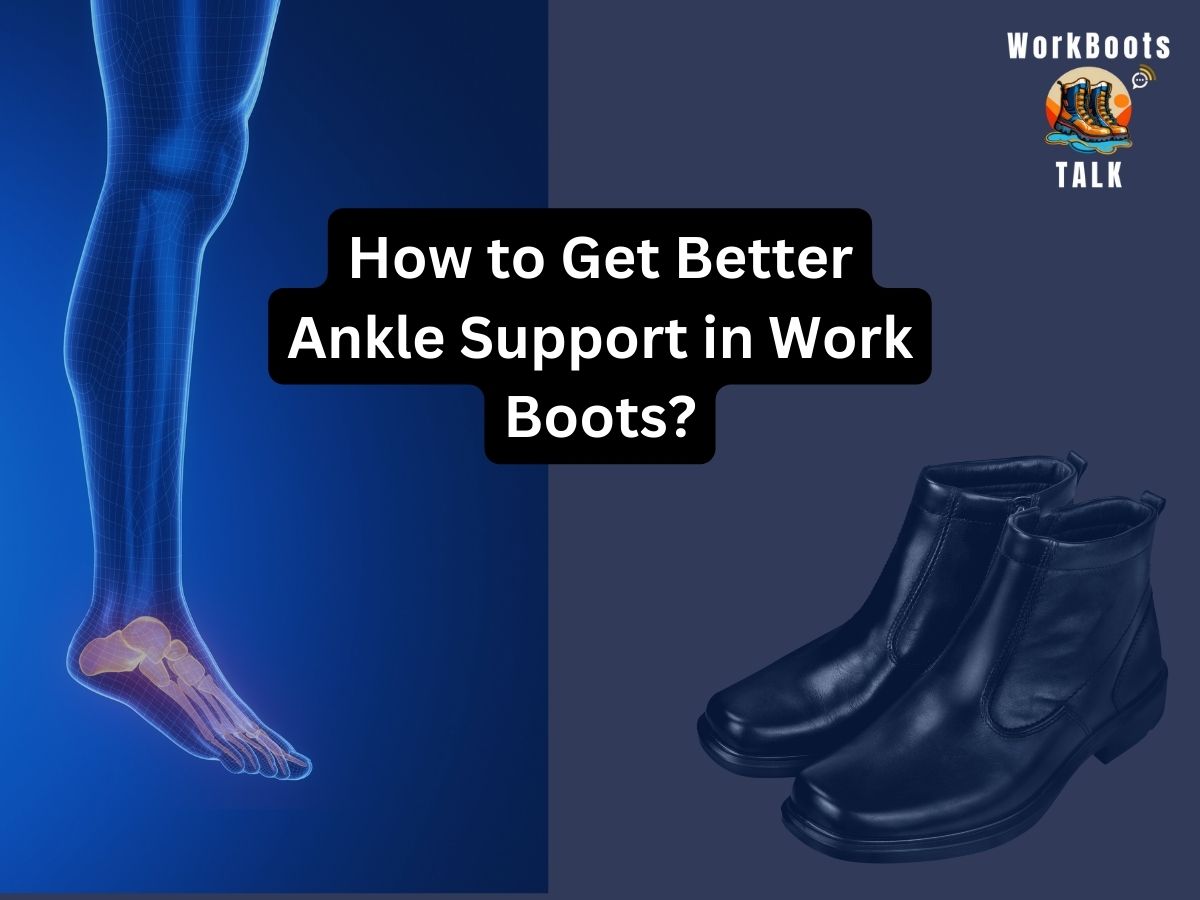Working on your feet all day in a challenging environment, such as construction or heavy industry, means you understand the importance of comfortable, supportive work boots. The stress and strain on your feet and ankles are significant, especially when navigating uneven ground, carrying heavy objects, wielding steel products, or moving across slippery floors. Proper ankle support in your work boots is crucial for both health and performance.
Ankle support work boots are specifically designed to safeguard against ankle injuries like sprains, twists, and fractures—a twisted ankle is a common work-related injury—while also aiding in balance and stability. This is key in preventing accidents such as slips, trips, and falls that could lead to serious injuries. Furthermore, the protective gear they offer contributes to improved posture and alignment, significantly lowering the risk of chronic pain in your feet, legs, and back.
In this post, we’ll dive into the significance of ankle support for your work environment, guide you in selecting work boots with the best ankle support, and provide tips to enhance ankle support in your boot choice. By adhering to this advice, you’ll discover the ideal work boots for your needs, ensuring a more comfortable and efficient workday.
Understanding the Importance of Ankle Support in Work Environments
Ankle support transcends mere comfort to touch on safety. Ankles, crucial for mobility and maintaining balance, are susceptible to numerous workplace hazards. We will delve into how ankle support can shield you from injuries at work and the various factors that escalate the risk of hurting your ankles on the job.
The Role of Ankle Support in Preventing Workplace Injuries
Ankle-supportive work boots serve as a fortress for your ankles against various injuries, among them:
- Sprains: Occur when the ligaments that bind your ankle bones are stretched or ruptured. Such injuries often result from awkward twists, rolls, or turns of your ankle.
- Fractures: Occur when extreme force or pressure, such as from falls, landings, or collisions, breaks one or more of your ankle bones.
- Strains: Result from overusing, overstressing, or suddenly contracting your ankle muscles, leading to stretched or torn tendons or muscles.
Ankle-supportive work boots contribute to injury prevention by offering stability, cushioning, and shock absorption. They mitigate the impact and stress on your ankles, particularly on uneven or slippery grounds. By donning such boots, you circumvent pain, swelling, bruising, and inflammation, thwarting chronic complications like instability, arthritis, or nerve damage.
Factors Contributing to Ankle Injuries at Work
Several factors heighten the risk of sustaining ankle injuries on the job, including:
- The nature of the job: Certain professions, such as construction, agriculture, mining, or manufacturing, carry a higher risk due to activities like heavy lifting, climbing, jumping, or navigating rough terrains.
- The type of footwear: Proper footwear that offers ankle support, such as boots or sneakers, should be chosen over inadequate styles like sandals. Footwear should snugly fit, provide ample traction, and support the arches while cushioning the feet. Ill-fitting, overly tight, or poorly designed shoes heighten the risk of injury.
- The kind of external injuries: Cuts, burns, punctures, or infections can compromise ankle integrity, making them more prone to further injury, infections, or complications by damaging the skin, muscles, nerves, or blood vessels.
Being mindful of these risk factors and adopting preventive strategies, such as wearing suitable ankle support work boots tailored to your work environment and foot type, is paramount.
Choosing the Right Work Boots for Optimal Ankle Support
Understanding the critical role that ankle support plays in work settings, you may be pondering on how to select the ideal work boots tailored to your necessities. It’s essential to note that work boots vary significantly, and particular characteristics significantly boost ankle support. This segment will guide you through the key features to seek in work boots dedicated to ankle support and offer advice on securing a perfect match for your feet.
Features That Enhance Ankle Support
Based on various sources, including reputable brands such as Timberland and Carhartt, here are essential features that bolster ankle support in work boots:
- Height: Boots that either cover the ankle or feature an extended shaft, like an 8-inch design, offer enhanced stability and safeguard for the ankles. Taller boots are also effective in keeping out dirt, debris, and moisture, ensuring your feet stay dry and comfortable.
- Cushioning: Work boots with ample cushioning in the insole and midsole deliver effective shock absorption, lessening the strain on your ankles. This cushioning not only boosts comfort but also wards off fatigue and discomfort.
- Arch Support: Boots designed with arch support or a removable footbed that molds to the shape of your foot ensure better foot and ankle alignment and balance. This feature aids in preventing issues caused by overpronation or supination, which can lead to ankle injuries.
- Shank: Incorporating a shank, a sturdy material placed along the sole, into a work boot provides additional support and rigidity for both the feet and ankles. The shank helps in preventing the boot from bending or twisting, actions that could potentially result in ankle sprains.
- Lacing: A boot that comes with an adaptable lacing system enables you to fine-tune the tightness and fit, offering enhanced stability and security for the ankles. Proper lacing also helps in preventing the boot from slipping, reducing the risk of ankle injuries.
While these features are paramount for enhanced ankle support in work boots, remember to also weigh other crucial factors such as safety, durability, and overall comfort. For instance, safety boots with steel-toe caps provide an extra layer of protection while working with heavy or hazardous items, and a tough rubber outsole offers reliable traction. The right midsoles can aid in the reduction of sore feet after lengthy shifts, and choosing boots with durable laces ensures they stay secure to minimize the risk of injury.
Certainly! Let’s break down the importance of selecting the right work boots more conversationally:
Finding the Perfect Fit
Finding boots that fit perfectly is equally significant for optimal ankle support to prevent issues like sore Achilles. Boots that are too tight, too loose, oversized, or undersized can lead to a myriad of ankle issues, including blisters, chafing, and swelling. Follow these tips to ensure you find boots that fit just right and support the Achilles area adequately:
- Measure Your Feet: Ideally, measure your feet towards the end of the day when they are at their largest. Utilize a size chart to pinpoint your precise size and remember to measure both feet as they could differ in size, opting for the size of the larger foot.
- Try On Your Boots: Always try the boots with the socks you intend to wear at work. Walk around for a bit to gauge how they feel. Pay close attention to the toe box, heel, arch, and ankle areas for any discomfort or misfit.
- Break In Your Boots: Gradually breaking in your boots is vital. Start by wearing them for a few hours each day, progressively increasing the duration as they become more comfortable. Applying heat or leather conditioner can also soften the material, making the breaking-in process smoother.
By adhering to these guidelines, you’re set to find the best-fitting work boots, ensuring you enjoy the utmost benefits of ankle support.

Additional Measures to Improve Ankle Support in Work Boots
While selecting the right work boots is essential for ankle support, there are further actions you can undertake to enhance ankle health and comfort. This part will cover the advantages of orthotic insoles and ankle braces, as well as offer maintenance advice for your work boots.
Use of Orthotic Insoles and Ankle Braces
Orthotic insoles, which can be custom-designed or off-the-shelf, are inserts that fit into your work boots, offering supplementary cushioning, arch support, and proper alignment for your feet and ankles. These insoles are invaluable for preventing or alleviating various foot issues, including plantar fasciitis, flat feet, high arches, pronation, and heel spurs, among others. Select insoles that match your foot type, work boot style, and specific requirements.
Ankle braces wrap around your ankles to provide additional compression, stability, and injury protection, making them particularly beneficial for those in rehab or recovering from work-related injuries such as a sprained or twisted ankle. Ensure you choose ankle braces that are compatible with your safety boots, fit your ankle size snugly without causing sore spots, and are appropriate for the intensity of your activities.
Utilizing orthotic insoles and ankle braces can significantly boost the support your work boots offer, improving both foot health and performance.
Maintenance Tips for Work Boots
Properly caring for your work boots is another crucial step in enhancing ankle support. Boots that are well looked after will last longer, function more effectively, and offer greater comfort and support for your feet and ankles. Here’s how to maintain them:
- Clean your work boots regularly: Use a brush, cloth, or a gentle soap and water mixture to remove any dirt, dust, or debris. Tackle stains like tar, cement, or grease with a plastic scraper, microfiber cloth, or a designated cleaner.
- Condition your work boots periodically: Keep the leather of your boots supple, moisturized, and protected by applying a leather conditioner, mink oil, or balm. Also, polish your work boots with wax or cream to rejuvenate their shine and colour.
- Waterproof your work boots occasionally: A waterproofing spray, cream, or wax can safeguard your boots against water damage and stains. Avoid immersing your boots in water or drying them with direct heat.
- Store your work boots properly: Keep them in a cool, dry, and ventilated place, away from sunlight or moisture. Use shoe trees, newspaper, or tissue paper to help maintain their shape and prevent creases or wrinkles.
- Repair or replace your work boots when needed: Regularly examine your work boots for signs of wear such as holes, cracks, or worn-out soles. Seek professional assistance to repair or replace any damaged or defective parts.
Adhering to these maintenance tips can prolong the lifespan of your work boots, ensuring they continue to provide the necessary ankle support.
Incorporating Insoles and Inserts
Certainly! Let’s break down the importance of incorporating insoles and inserts into your work boots in a more conversational way:
1. Benefits of Supportive Insoles:
- Comfort Cushion: Supportive insoles add an extra layer of cushioning, making those long work hours easier on your feet.
- Arch Support: They help maintain the natural arch of your foot, preventing discomfort and fatigue.
- Shock Absorption: Insoles absorb shocks, reducing stress on your ankles and joints.
2. Custom Orthotics for Personalized Comfort:
- Tailored Fit: Custom orthotics are designed specifically for your unique foot shape, ensuring personalized comfort.
- Addressing Issues: They can target specific foot conditions or imbalances, contributing to overall foot health.
- Long-Term Benefits: Investing in custom orthotics may prevent future foot problems and enhance your overall comfort at work.
3. How Insoles Contribute to Ankle Stability:
- Improved Alignment: Insoles help align your foot correctly, promoting stable movement and preventing strain on the ankles.
- Enhanced Support: They provide additional support to the arch and heel, contributing to overall ankle stability.
- Compatibility with Boots: Many work boots allow you to insert insoles, ensuring compatibility for personalized comfort and stability.
By paying attention to what’s inside your boots, you’re not only prioritizing comfort but also taking important steps toward maintaining ankle stability crucial factor for a productive and injury-free work experience.

Tips for Enhancing Ankle Strength
Keeping your ankles strong and healthy isn’t just about the boots you wear – it’s also about taking care of your body.
A. Easy Exercises for Stronger
- Ankles Toe Taps: Lift your toes while keeping your heels down, then switch.
- Ankle Circles: Rotate your ankles in both directions to boost flexibility and strength.
- Calf Raises: Go up on your toes, then lower down, working those ankle muscles.
B. Stretching for Work Boot Wearers
- Calf Stretches: Lean against a wall and stretch one leg back to feel your calf stretch.
- Achilles Stretch: Stand on a step and let one heel drop below the step to stretch your Achilles tendon.
- Towel Stretch: Sit with legs out straight, loop a towel around your foot, and pull gently to stretch your calf.
C. Building Ankle Resilience Over Time
- Take it Slow: Start with easy exercises and gradually make them harder to prevent injuries.
- Stay Consistent: Regularly do ankle exercises and stretches for lasting benefits.
- Listen to Your Body: If you feel pain, adjust or stop and consult a professional if needed.
- By doing these simple exercises and stretches regularly, you not only strengthen your ankles immediately but also build long-term resilience, reducing the risk of injuries and improving your overall well-being, especially for those who wear work boots regularly.
Conclusion
Ensuring ankle support in your workplace is essential for mitigating risks of ankle injuries including sprains, fractures, or strains. These injuries may lead to pain, swelling, inflammation, and complications, notably impacting your mobility and balance. As such, it’s wise to equip yourself with ankle support work boots like those offered by Timberland or Carhartt, which are engineered with features such as robust midsoles and outsoles to provide invaluable protection against potential hazards.
To select the ideal work boots for superb ankle support, consider characteristics like boot height, cushioning, arch support, shank presence, and the lacing system. Finding a perfect fit is critical—measure your feet accurately, try the boots on, and properly break them in. For an enhanced supportive experience, consider pairing your work boots with orthotic insoles and ankle braces. Don’t forget to care for your boots regularly to maintain their quality and functionality over time.
By adhering to these suggestions, you’ll fully benefit from ankle-supported work boots, enjoying increased comfort, stability, protection, and overall foot health. This support can also contribute to better work productivity and performance, and assist in the prevention and management of any potential ankle problems. Therefore, don’t delay in acquiring the best work boots for effective ankle support today!
Frequently Asked Questions
1. How do I get more ankle support in my shoes?
Opt for high-top shoes or boots with built-in ankle support mechanisms. Consider using supportive insoles for additional reinforcement.
2. How do I stop my boots from hurting my ankles?
Ensure proper sizing, choose boots with padded collars, and use quality insoles for added comfort and support.
3. Why do my work boots hurt my ankles?
Possible reasons include improper sizing, lack of adequate ankle support features, or worn-out boots. Consider investing in well-fitted, supportive boots.
4. Do work boots give ankle support?
Yes, many work boots are designed with ankle support features, such as high-top designs, lace-up systems, and additional supportive elements.
5. How do I get good ankle support?
Choose footwear with high-top designs, lace-up systems, and features like padded collars. Ensure proper sizing and consider using supportive insoles.
6. Why do my boots sag at the ankle?
Sagging may result from worn-out or improperly fitted boots. Regularly check for signs of wear and tear and replace boots when needed.
7. Why do ankle boots hurt my feet?
Common reasons include poor sizing, lack of support features, or insufficient cushioning. Opt for well-fitted boots with proper support.
8. How do you wear ankle boots without pain?
Ensure the boots are the right size, choose styles with ample cushioning and support features, and consider using supportive insoles.
9. Should ankle boots be tight or loose?
Ankle boots should provide a snug fit without being overly tight. Avoid excessive looseness to maintain stability and support.
10. Why do my boots hurt the bottom of my feet?
Discomfort may stem from inadequate arch support or worn-out insoles. Invest in quality insoles and ensure proper arch support.
11. Why are ankle boots uncomfortable?
Uncomfortable ankle boots may result from poor design, lack of support features, or improper sizing. Choose well-designed and supportive options.
12. Do ankle boots go over or under jeans?
Both styles are acceptable. Wearing ankle boots over jeans creates a modern look, while tucking jeans into boots provides a classic appearance.

